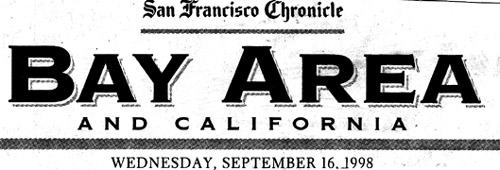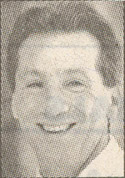 |
 |
| In-Line Skaters May
Join S.F. Traffic Crush Pilot program would allow travel on designated streets |
| By Edward Epstein
Chronicle Staff Writer A San Francisco supervisors committee paved the way yesterday for a pioneering pilot program that would allow skater commuters to share some streets with cars and bicycles. The measure, which the full board will vote on next Tuesday, would designate up to 40 miles of the city's bike routes for sharing by in-line skaters, bikes and cars. But skaters could not use striped bike lanes, which are set aside solely for bicycles. It is now illegal for skaters to be in the streets, on sidewalks in business districts or to skate after dark. Enforcement is spotty. "This program will allow adults to use in-line skates as a way to get to work or school," said the measure's sponsor, Supervisor Tom Ammiano. He has been working on the legislation, which skating activists say is the first in the United States, for more than a year. |
| The pilot program passed by the
Economic Development, Transportation and Technology Committee would expire December 31,
1999, unless the supervisors and the mayor renew it. Skaters would have to follow a host
of rules and restrictions. Only those 18 and older could participate. They would have to
travel in single file, in the direction of traffic. They would have to use protective
helmets and would be barred from wearing headphones. At night, they would have use lamps
and red reflectors. All skaters would have to sign a certificate, issued free of charge by the Department of Parking and Traffic, showing that they are aware of all the rules and of the designated routes. Fines would range from $25 for the first offense to $250 for repeat offenders.The routes would be picked out by the parking and traffic staff, probably in consultation with a new skating advisory committee. Because the city cannot use its bike lanes and because sponsors want to avoid conflict with Municipal Railway buses and streetcars, the skate-commuting system would not be complete. |
 Tom Ammiano has been working on the program for more than a year. |
| Anyone who wanted to get downtown on
skates would probably have to walk or ride Muni part of the way. That is because they
would not be able to use most busy streets downtown or South of Market. Townsend Street
would probably be a skating route, and skaters' would have use other means to get
downtown. At the outset, the numbers of people participating will not be that high," said David Miles of the California Outdoor Rollerskating Association, a main backer of the measure. "This will take a considerable level of skating ability."He said that perhaps 50 people would take the plunge initially, but that figure could grow as word gets around. "I'm pretty confident I this will work," he said. Supervisor Mark Leno said there would have to be a broad public awareness program associated with the plan. "It's going to take time for drivers or people on bicycles to get used to this," he said. "We need an education campaign to short-circuit these problems." 'The education process is just beginning, according to 50 cyclists who demonstrated outside City Hall last night to push for improved public transit and greater acceptance of alternatives to cars. A real commitment from city leaders is the key to making San Francisco's streets safer for pedestrians, bicyclists and skaters, said. Ann Halton, a San Francisco housekeeper who was among the demonstrators."Too many people come into the city in cars because they're afraid to take public transportation," she said. "They think it's unsafe and unreliable. It's dangerous and frustrating when I ride my bike, but it sure beats Muni." The demonstrators' group, which called itself Get a Grip, waited for an hour hoping to be granted an audience with Mayor Willie Brown. Standing outside City Hall, many rang their bike bells and shouted, "Hey Willie." The mayor did not respond. . Chronicle staff writer Julie N. Lynem contributed to this report. |